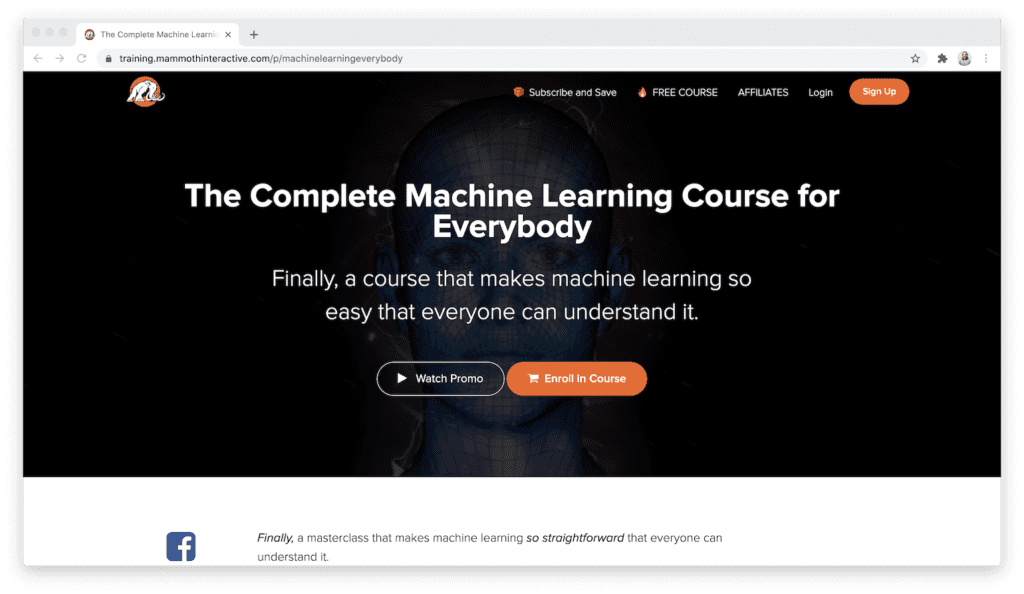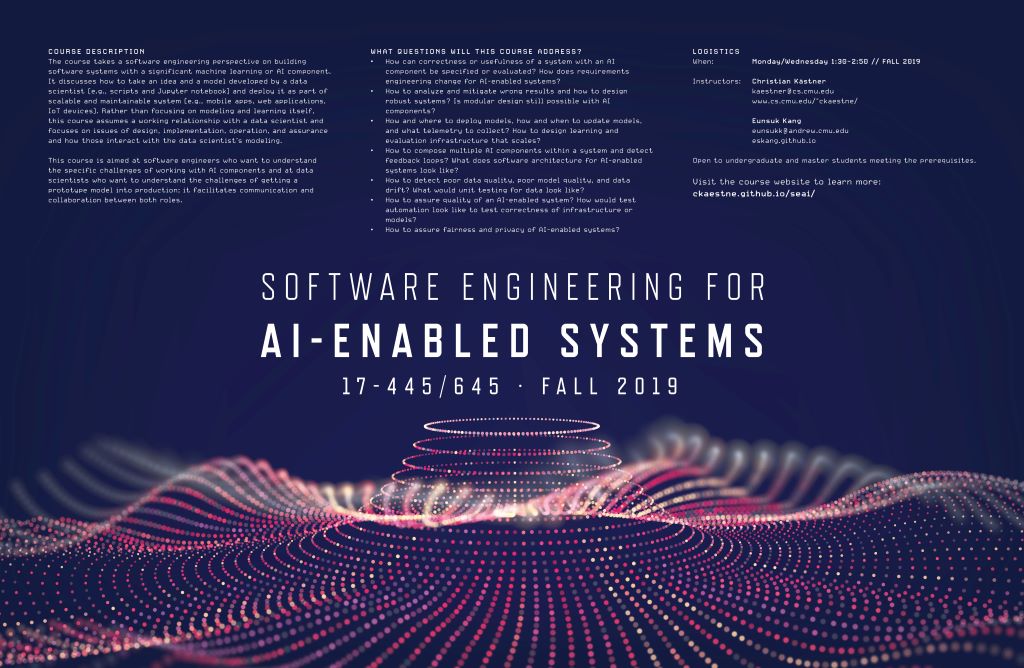All Categories
Featured
Table of Contents
- – Excitement About Machine Learning Engineering ...
- – Machine Learning In Production Things To Know ...
- – The Definitive Guide for Software Engineering...
- – How Online Machine Learning Engineering & Ai ...
- – The Best Guide To Machine Learning Online Co...
- – The 25-Second Trick For Machine Learning Boo...
You most likely understand Santiago from his Twitter. On Twitter, every day, he shares a lot of functional things about equipment learning. Alexey: Prior to we go into our major topic of relocating from software application design to machine discovering, perhaps we can start with your history.
I began as a software application developer. I went to college, got a computer technology level, and I began developing software. I assume it was 2015 when I chose to go for a Master's in computer system science. Back after that, I had no idea about artificial intelligence. I really did not have any kind of passion in it.
I understand you have actually been utilizing the term "transitioning from software application design to artificial intelligence". I such as the term "contributing to my ability the device knowing skills" much more due to the fact that I assume if you're a software engineer, you are currently giving a great deal of value. By integrating artificial intelligence currently, you're augmenting the impact that you can have on the market.
Alexey: This comes back to one of your tweets or perhaps it was from your course when you compare 2 methods to discovering. In this case, it was some issue from Kaggle regarding this Titanic dataset, and you just learn just how to resolve this trouble utilizing a particular device, like choice trees from SciKit Learn.
Excitement About Machine Learning Engineering Course For Software Engineers
You first find out math, or direct algebra, calculus. When you understand the mathematics, you go to equipment understanding concept and you learn the concept. Then four years later, you ultimately involve applications, "Okay, exactly how do I utilize all these four years of mathematics to fix this Titanic problem?" Right? In the previous, you kind of save yourself some time, I assume.
If I have an electric outlet right here that I need changing, I don't want to go to college, invest four years comprehending the math behind electrical power and the physics and all of that, simply to change an electrical outlet. I would certainly instead begin with the outlet and find a YouTube video that helps me undergo the problem.
Negative analogy. You obtain the concept? (27:22) Santiago: I really like the concept of beginning with a problem, attempting to toss out what I recognize up to that problem and understand why it doesn't function. Grab the tools that I need to solve that issue and start excavating deeper and much deeper and much deeper from that point on.
Alexey: Possibly we can speak a bit about finding out resources. You pointed out in Kaggle there is an intro tutorial, where you can obtain and discover how to make choice trees.
The only need for that training course is that you understand a little bit of Python. If you go to my account, the tweet that's going to be on the top, the one that says "pinned tweet".
Machine Learning In Production Things To Know Before You Get This

Also if you're not a designer, you can start with Python and function your method to more device discovering. This roadmap is focused on Coursera, which is a platform that I really, really like. You can examine all of the courses completely free or you can spend for the Coursera registration to get certificates if you wish to.
That's what I would do. Alexey: This returns to among your tweets or maybe it was from your training course when you compare 2 strategies to understanding. One strategy is the issue based strategy, which you just chatted about. You find a problem. In this situation, it was some trouble from Kaggle regarding this Titanic dataset, and you simply discover just how to address this problem making use of a details device, like choice trees from SciKit Learn.

You first learn math, or direct algebra, calculus. When you know the math, you go to maker learning concept and you discover the theory. Four years later, you ultimately come to applications, "Okay, how do I utilize all these 4 years of mathematics to resolve this Titanic trouble?" Right? In the former, you kind of conserve yourself some time, I believe.
If I have an electrical outlet here that I require changing, I don't desire to most likely to university, invest four years comprehending the mathematics behind power and the physics and all of that, simply to change an electrical outlet. I would instead start with the outlet and find a YouTube video that aids me undergo the problem.
Santiago: I actually like the idea of starting with a problem, trying to throw out what I know up to that problem and understand why it doesn't function. Grab the tools that I require to solve that issue and start excavating much deeper and much deeper and deeper from that point on.
That's what I usually advise. Alexey: Maybe we can chat a little bit concerning learning sources. You mentioned in Kaggle there is an introduction tutorial, where you can get and discover how to make choice trees. At the beginning, before we started this interview, you stated a couple of publications.
The Definitive Guide for Software Engineering Vs Machine Learning (Updated For ...
The only requirement for that training course is that you know a little of Python. If you're a designer, that's a wonderful base. (38:48) Santiago: If you're not a developer, after that I do have a pin on my Twitter account. If you go to my profile, the tweet that's mosting likely to get on the top, the one that states "pinned tweet".
Also if you're not a designer, you can start with Python and work your way to more machine knowing. This roadmap is concentrated on Coursera, which is a platform that I really, actually like. You can audit all of the training courses free of cost or you can spend for the Coursera registration to get certifications if you desire to.
How Online Machine Learning Engineering & Ai Bootcamp can Save You Time, Stress, and Money.
To ensure that's what I would do. Alexey: This returns to one of your tweets or possibly it was from your course when you compare two approaches to understanding. One technique is the problem based strategy, which you just discussed. You find a trouble. In this situation, it was some issue from Kaggle concerning this Titanic dataset, and you simply learn just how to solve this trouble using a certain tool, like decision trees from SciKit Learn.

You initially learn math, or linear algebra, calculus. When you understand the math, you go to device discovering theory and you find out the theory. Four years later, you finally come to applications, "Okay, how do I utilize all these 4 years of mathematics to resolve this Titanic trouble?" Right? In the former, you kind of save yourself some time, I think.
If I have an electric outlet here that I need replacing, I do not wish to most likely to college, spend 4 years comprehending the math behind electricity and the physics and all of that, just to alter an outlet. I would certainly instead begin with the outlet and discover a YouTube video that assists me undergo the issue.
Bad analogy. You obtain the idea? (27:22) Santiago: I truly like the idea of starting with an issue, attempting to toss out what I recognize as much as that problem and understand why it does not work. Then get the devices that I need to solve that trouble and begin digging deeper and much deeper and deeper from that point on.
Alexey: Maybe we can speak a little bit about learning sources. You stated in Kaggle there is an intro tutorial, where you can obtain and discover how to make choice trees.
The Best Guide To Machine Learning Online Course - Applied Machine Learning
The only demand for that training course is that you know a little bit of Python. If you go to my account, the tweet that's going to be on the top, the one that claims "pinned tweet".
Even if you're not a programmer, you can begin with Python and work your method to more artificial intelligence. This roadmap is concentrated on Coursera, which is a system that I actually, really like. You can investigate all of the training courses totally free or you can pay for the Coursera registration to obtain certificates if you intend to.
Alexey: This comes back to one of your tweets or perhaps it was from your training course when you compare two methods to discovering. In this situation, it was some issue from Kaggle about this Titanic dataset, and you simply learn exactly how to solve this trouble utilizing a certain device, like decision trees from SciKit Learn.
You first discover mathematics, or linear algebra, calculus. When you understand the mathematics, you go to machine discovering theory and you find out the theory.
The 25-Second Trick For Machine Learning Bootcamp: Build An Ml Portfolio
If I have an electric outlet below that I require changing, I don't intend to most likely to college, spend four years comprehending the mathematics behind electrical energy and the physics and all of that, simply to transform an electrical outlet. I would certainly rather begin with the electrical outlet and find a YouTube video clip that aids me experience the trouble.
Santiago: I actually like the concept of starting with a trouble, attempting to throw out what I know up to that problem and recognize why it doesn't work. Get the devices that I need to fix that issue and begin digging deeper and deeper and deeper from that point on.

That's what I normally advise. Alexey: Maybe we can talk a little bit concerning finding out sources. You discussed in Kaggle there is an introduction tutorial, where you can obtain and discover exactly how to make decision trees. At the beginning, prior to we started this interview, you discussed a couple of books too.
The only demand for that training course is that you recognize a bit of Python. If you're a designer, that's a great base. (38:48) Santiago: If you're not a developer, then I do have a pin on my Twitter account. If you most likely to my profile, the tweet that's mosting likely to get on the top, the one that says "pinned tweet".
Also if you're not a developer, you can begin with Python and work your means to more artificial intelligence. This roadmap is concentrated on Coursera, which is a system that I truly, really like. You can audit every one of the courses totally free or you can pay for the Coursera membership to get certifications if you intend to.
Table of Contents
- – Excitement About Machine Learning Engineering ...
- – Machine Learning In Production Things To Know ...
- – The Definitive Guide for Software Engineering...
- – How Online Machine Learning Engineering & Ai ...
- – The Best Guide To Machine Learning Online Co...
- – The 25-Second Trick For Machine Learning Boo...
Latest Posts
The Best Mock Interview Platforms For Software Engineers
How To Use Openai & Chatgpt To Practice Coding Interviews
How To Answer “Tell Me About Yourself” In A Software Engineering Interview
More
Latest Posts
The Best Mock Interview Platforms For Software Engineers
How To Use Openai & Chatgpt To Practice Coding Interviews
How To Answer “Tell Me About Yourself” In A Software Engineering Interview